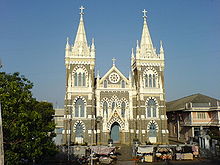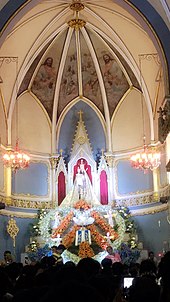Basilica of Our Lady of the Mountains (Mumbai)
The Basilica of Our Lady of the Mountains ( English Mount Mary's Church , Portuguese Nossa Senhora de Monte ) is a Roman Catholic chapel and the destination of a Marian pilgrimage in Bandra , a northern suburb of Mumbai , India , located directly on the sea . The church of the Archdiocese of Bombay is dedicated to Mary , the Mother of God , and has the title of a minor basilica . It was built in the local neo-Gothic style at the beginning of the 20th century and houses a statue of the Virgin Mary from Portugal .
history
In the 16th century, Bandra was a Koli fishing village that has now become a lively suburb of the Indian metropolis of Mumbai. Jesuit missionaries from Portugal brought a wooden statue of the Virgin Mary from Portugal to Bandra in 1570, probably via Fort Bassein, for which a modest oratory was built, which attracted pilgrims. In 1640 the oratory was enlarged into a chapel which belonged to the new parish of St. Andrew.
At the end of the 17th century, Arab pirates destroyed the chapel and disfigured the statue in search of gold and other valuable materials. The statue was replaced by another from the parish of St. Andrew. The last Jesuit left the sanctuary in 1739, and the Marathas marched into an uncertain period of standstill. In 1761 the religious building was rebuilt for the third time. The old wooden statue, repaired and with the addition of the baby Jesus, was put up again. The Archbishop of Goa appointed the brotherhood Nossa Senhora de Monte to take care of it. In 1848, with the help of a large donation, a road was built to the sanctuary, which was renovated in 1869. At the end of the 19th century, the opening of the railway line along the west coast of India with a stop in Bandra made pilgrimages easier, which increased the number of pilgrims.
In 1902, the foundation stone for today's fourth building was laid by Archbishop António Sebastião Valente , who was also buried in the sanctuary. The architect SN Chandabhoy designed the church in the neo-Byzantine style in a neo-Gothic style, influenced by the English. Despite a local plague epidemic, the project went ahead and the church was completed in 1904 for the 50th anniversary of the dogma of the Immaculate Conception . It is visible from afar on a rocky promontory about 40 meters above the Arabian Sea . The old, fully restored statue of Our Lady is located above the main altar at the back of the sanctuary.
In 1943, Bishop Thomas Roberts , Archbishop of Bombay, granted the sanctuary independent status with its own rector. On the occasion of the Marian Year 1954, an oratory of the Madonna of Fatima was erected opposite the church . The statue of Our Lady of the Mountain visited the parishes of Bombay and the suburbs. When she returned on December 5, she was crowned by Cardinal Valerian Gracias , who had previously served as the parish chaplain in Bandra. In the same year, 1954, the sanctuary was opened by Pope Pius XII. raised to a minor basilica in its significance as a place of pilgrimage to Mary . During the 38th World Eucharistic Congress Paul VI visited 1964 the basilica, in 1986 John Paul II followed him during his pastoral visit.
architecture
The architect SN Chandabhoy designed the church in a neo-Gothic style that was influenced by the English. The colorful design is influenced by neo-Byzantine and Indian styles. The 21 m wide double tower facade faces the sea on a slope. The brick walls are set off with natural stone. The lower floor includes the wooden main door between two windows, which is protected from the weather by two Gothic stone arches, which are flanked by columns. The second floor has five windows and symbols of the Virgin Mary. The third floor is a triangular gable with a rose window and the year of construction. The church towers have pyramid-shaped roofs with crosses that tower about 30 meters high. Both wear bells.
The church is designed as a three-aisled basilica , the nave measures 30 meters. The chancel is raised and presents the high altar with the statue of the Virgin Mary in a round apse behind a triumphal arch . Galleries have been built over the side aisles, the columns are made of teak . The side walls are decorated with large pictures of the life of Mary. The side altars are dedicated to Joseph the Worker and the Sacred Heart .
Pilgrimage
Koli fishermen, both Hindus and Christians, have visited the sanctuary since it was built. The main festival of the Marian shrine under the name Bandra-Fair is the feast of the birth of the Virgin Mary on September 8th, which is celebrated here on the following Sunday. This is the occasion of a large Bandra fair that lasts a week and enlivens the entire district. It is the time of the greatest pilgrimage, both individual pilgrims and groups. Many thousands, Christians and others, visit the basilica for a syncretistic festival.
Web links
Individual evidence
- ^ Basilica of Our Lady of the Mount on gcatholic.org
- ↑ History of the Basilica (English)
- ↑ Architecture (English)
Coordinates: 19 ° 2 ′ 48 ″ N , 72 ° 49 ′ 21 ″ E


